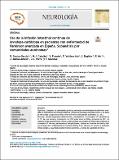Por favor, use este identificador para citar o enlazar a este item:
http://hdl.handle.net/10261/233654COMPARTIR / EXPORTAR:
 SHARE SHARE
 CORE
BASE CORE
BASE
|
|
| Visualizar otros formatos: MARC | Dublin Core | RDF | ORE | MODS | METS | DIDL | DATACITE | |

| Título: | Uso de la infusión intestinal continua de levodopa-carbidopa en pacientes con enfermedad de Parkinson avanzada en España. Subanálisis por comunidades autónomas |
Otros títulos: | Continuous intestinal infusion of levodopa-carbidopa in patients with advanced Parkinson's disease in Spain: Subanalysis by autonomous community | Autor: | Santos-García, Diego; Catalán, M. J.; Puente, Víctor; Valldeoriola, Francesc; Regidor, Ignacio; Mir, Pablo CSIC ORCID; Matías-Arbelo, J.; Parra, Juan Carlos; Grandas, Francisco | Palabras clave: | Levodopa Carbidopa Enfermedad de Parkinson Infusión continua Síntomas motores Efectividad Parkinson's disease Continuous infusion Motor symptoms Effectiveness |
Fecha de publicación: | mar-2020 | Editor: | Elsevier | Citación: | Neurología 36(2): 101-111 (2020) | Resumen: | [ES] Objetivos: Comparar las características de los pacientes con enfermedad de Parkinson avanzada en tratamiento con infusión intestinal continua de levodopa-carbidopa (IICLC) y los datos de efectividad y seguridad de IICLC entre diferentes comunidades autónomas (CC. AA.).
Métodos: Estudio longitudinal observacional y retrospectivo. Se incluyeron 177 pacientes de 11 CC. AA. que iniciaron tratamiento con IICLC entre enero de 2006 y diciembre de 2011. Se compararon las características clínicas y demográficas, las variables de efectividad (cambios en el tiempo OFF, ON con y sin discinesias discapacitantes, cambios en la escala de Hoehn y Yahr y puntuación de la Unified Parkinson's Disease Rating Scale, síntomas no motores e Impresión Clínica Global) y seguridad (acontecimientos adversos), y la tasa de suspensión de IICLC.
Resultados: Se hallaron diferencias significativas entre las CC. AA. en diversas variables basales: duración de la enfermedad hasta el inicio de IICLC, tiempo OFF (34,9-59,7%) y ON (con o sin discinesias; 2,6-48,0%), Hoehn y Yahr en ON, Unified Parkinson's Disease Rating Scale-III en ON y OFF, presencia de ≥ 4 síntomas motores y dosis de IICLC. En el seguimiento (> 24 meses en 9 de 11 CC. AA.) hubo diferencias significativas en el porcentaje de tiempo OFF, tiempo ON sin discinesias discapacitantes, frecuencia de acontecimientos adversos e Impresión Clínica Global. La tasa de suspensión fue de entre 20-40% en todas las CC. AA., excepto en 2 (78 y 80%).
Conclusiones: Este estudio muestra una amplia variabilidad en la selección de los pacientes y en la efectividad y seguridad de IICLC entre las diferentes CC. AA. Podrían influir las características basales de los pacientes, la disponibilidad de un equipo multidisciplinar y la experiencia clínica. [EN] Objectives: To compare the characteristics of patients undergoing treatment with continuous intestinal infusion of levodopa-carbidopa (CIILC) for advanced Parkinson's disease and the data on the effectiveness and safety of CIILC in the different autonomous communities (AC) of Spain. Methods: A retrospective, longitudinal, observational study was carried out into 177 patients from 11 CAs who underwent CIILC between January 2006 and December 2011. We analysed data on patients’ clinical and demographic characteristics, variables related to effectiveness (changes in off time/on time with or without disabling dyskinesia; changes in Hoehn and Yahr scale and Unified Parkinson's Disease Rating Scale scores; non-motor symptoms; and Clinical Global Impression scale scores) and safety (adverse events), and the rate of CIILC discontinuation. Results: Significant differences were observed between CAs for several baseline variables: duration of disease progression prior to CIILC onset, off time (34.9-59.7%) and on time (2.6-48.0%; with or without disabling dyskinesia), Hoehn and Yahr score during on time, Unified Parkinson's Disease Rating Scale-III score during both on and off time, presence of ≥ 4 motor symptoms, and CIILC dose. Significant differences were observed during follow-up (> 24 months in 9 of the 11 CAs studied) for the percentage of off time and on time without disabling dyskinesia, adverse events frequency, and Clinical Global Impression scores. The rate of CIILC discontinuation was between 20-40% in 9 CAs (78 and 80% in remaining 2 CAs). Conclusions: This study reveals a marked variability between CAs in terms of patient selection and CIILC safety and effectiveness. These results may have been influenced by patients’ baseline characteristics, the availability of multidisciplinary teams, and clinical experience. |
Versión del editor: | http://doi.org/10.1016/j.nrl.2017.11.006 | URI: | http://hdl.handle.net/10261/233654 | DOI: | 10.1016/j.nrl.2017.11.006 | Identificadores: | doi: 10.1016/j.nrl.2017.11.006 issn: 0213-4853 e-issn: 1578-1968 |
| Aparece en las colecciones: | (IBIS) Artículos |
Ficheros en este ítem:
| Fichero | Descripción | Tamaño | Formato | |
|---|---|---|---|---|
| levodopa-carbidopa.pdf | 1,16 MB | Adobe PDF |  Visualizar/Abrir |
CORE Recommender
Page view(s)
106
checked on 07-may-2024
Download(s)
287
checked on 07-may-2024
Google ScholarTM
Check
Altmetric
Altmetric
Este item está licenciado bajo una Licencia Creative Commons

